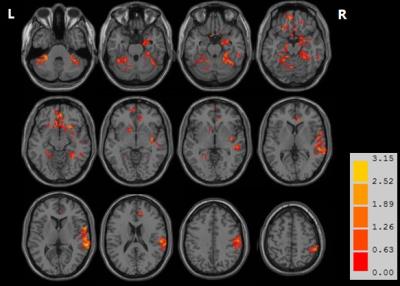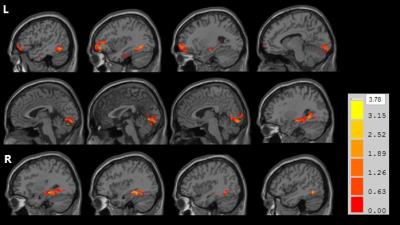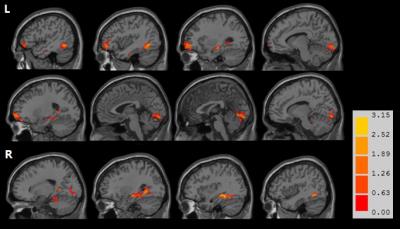4115
Increased Global Functional Connectivity in Hormonal Maturation Girls: a Resting-State Functional MRI Study1Huaxi MR Research Center (HMRRC), Department of Radiology, West China Hospital of Sichuan University, Chengdu, People's Republic of China, 2Radiology, The Second Affiliated Hospital & Yuying Children’s Hospital of Wenzhou Medical University, Wenzhou, People's Republic of China, 3Child Health Care, The Second Affiliated Hospital & Yuying Children’s Hospital of Wenzhou Medical University, Wenzhou, People's Republic of China
Synopsis
To investigate the impact of hormone maturation on brain function and psychological development, seventy-three girls aged 6-11 years were enrolled. Using the global voxel-wise functional connectivity, we found that girls with hormonal maturation showed significantly greater functional connectivity strength mainly in the default mode network and limbic system, relative to girls who were not hormonally maturated. While these two networks contribute substantially to the social cognition, cognitive processing and emotion regulation, our finding suggested that the hormonal maturation manifested its effects greatly on regions which are crucial to the social, self-referencial, and emotional cognition development.
INTRODUCTION
Puberty is an important period of brain maturation marked by significant social, cognitive and emotional development. Meanwhile, it is also a sensitive period readily being affected during the brain refinement, and occurs as a consequence of a defective maturational process manifesting as psychiatric disorders. Actually, puberty is initiated by the activation of the hypothalamus-pituitary-gonadal (HPG) axis via changes in pubertal hormones including increases in luteinizing hormone (LH) and follicle stimulating hormone (FSH) levels [1]. Though evidence of animal studies suggested that the hormonal events of puberty exerted specific effects on brain maturation and behavior [2], little is known for regarding the effect of puberty, especially with its associated hormonal influences, on early adolescent brain development in humans. Thus, in the present study, we investigated the impact of hormonal maturation on brain function, with the aim to explore the potential effects of pubertal hormones on brain connection in young girls.METHODS
The study was approved by the local research ethics committee, and written informed consent was obtained from all participants and their parents. Seventy-three girls between the age of 6 and 11 years were recruited. They were firstly subjected to gonadotrophin releasing hormone (Gn-RH) provocation test to assess hormonal maturation status. Psychological ratings were assessed using the Child Behavior Checklist and Wechsler Intelligence Scale. High-field resting-state fMRI scanning was performed on a 3T scanner with an eight-channel phase array head coil and a GE-EPI sequence (TR=2500ms, TE=40ms, flip angle=90°, slice thickness=4mm, slice gap=4mm, matrix 64×64, field of view=256×256, 34 axial slices). Blood samples of all the subjects were collected at three time points: immediately after provocation, 30 and 60 min after injecting Gn-RH in the morning of 8 o'clock. A peak stimulated serum LH level of >5 IU/L by using ultrasensitive assays is considered as an evidence of HPG-axis activation with hormonal maturation [3]. Finally, 50 girls were categorized as showing luteinizing hormonal maturation (LHM+, peak stimulated serum LH level>5 IU/L) whereas the other 23 were categorized as not showing luteinizing hormonal maturation (LHM-, peak stimulated serum LH level<5 IU/L). Global voxel-wise functional connectivity strength (FCS) was calculated across all the subjects to provide a whole-brain characterization of intrinsic functional architecture using DPARSFA (http://www.restfmri.net), and compared between groups with age, BMI included as covariates. Voxel-wise correlation analysis was also used to examine the relationship between the intrinsic functional connectivity and pubertal hormones as well as psychological ratings.RESULTS
Girls with hormonal maturation showed greater significantly increased voxel-wise FCS mainly in right superior and middle temporal gyrus, bilateral medial frontal cortex, right hippocampus, right parahippocampus, right supramarginal gyrus and cerebellum, relative to those who were not hormonally maturated (p<0.05, GRF corrected). Further analysis revealed that in the LHM+ girls, higher LH was positively correlated with stronger voxel-wise FCS of the left lingual gyrus and left middle temporal gyrus, whilst higher FSH was positively correlated with the same stronger voxel-wise FCS of left inferior temporal gyrus, left hippocampus, right lingual gyrus, right calcarine gyrus and left middle orbital frontal gyrus (p<0.05, GRF corrected). The FCS of regions with significant inter-group difference did not show any association with clinical ratings (p>0.05, GRF corrected).DISCUSSION
LHM+ girls showed increased FCS mainly in the default-mode network and limbic system. Default-mode network is a higher-level cognitive network and consists of brain regions that typically activate during resting state, within which a set of regions connectively contributes to perception of social cognition, self-related mental representations, and interaction between cognitive processing and emotional state [4,5]. Especially, the increased FCS manifested its great efficacy in dorsalmedial and ventromedial prefrontal cortex, which are associated with theory of mind skills needed for social relationships. On the other hand, the limbic system is the central part of the “emotion circuitry”, dedicating to the processing and regulation of emotion. The enhanced FCS in these two networks suggested a pivotal role of them in the cognitive and psychological development among these hormonally matured girls.CONCLUSION
As one of the few studies trying to trace the effects of hormone on brain function, our finding suggested that hormonal maturation were exerting effects on invoking and activating brain regions which are crucial to the social, self-referencial, and emotional cognition development. Future studies are needed to elucidate its causes and implications.Acknowledgements
This work was supported by National Natural Science Foundation of China (Grant numbers 81371527, 81671664, 81621003), National Key Technologies R&D Program (grant number 2012BAI01B03) and National Program for Support of Top-notch Young Professionals.References
1. Peper JS, Brouwer RM, van Leeuwen M et al. HPG-axis hormones during puberty: a study on the association with hypothalamic and pituitary volumes. Psychoneuroendocrinology. 2010; 35(1):133-40.
2. Blakemore SJ, Burnett S, Dahl RE. The role of puberty in the developing adolescent brain. Human brain mapping. 2010; 31(6):926-33.
3. Menon PS. Precocious Puberty, GnRH Stimulation Test and Monitoring GnRH Analog Therapy. Indian journal of pediatrics. 2015; 82(11):980-2.
4. Raichle M, MacLeod A, Snyder A et al. A default mode of brain function. Proc Natl Acad Sci U S A. 2001; 98(2):676-82.
5. Buckner R, Andrews J, Schacter D. The brain's default network: anatomy, function, and relevance to disease. Ann N Y Acad Sci. 2008; 1124:1-38.
Figures


